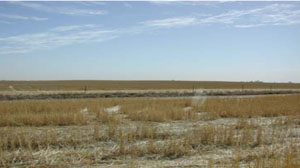WLRA129
|
| WLRA129 |  Bleached-Sodic, Eutrophic, Red Dermosols | |
|
Location | Jeparit Road, Peppers Plains, western Victoria | |||
|
Landform | Undulating plain | |||
|
Geology | Quaternary Woorinen Formation: aeolian dune sand, calcareous clay | |||
|
Element | Rise crest | |||
|
Slope | 2–3% North-west | |||
Horizon | Depth (cm) | Description | ||
A11 | 0–5 | Dark reddish brown (5YR3/2); sandy loam; medium to very fine moderate polyhedral structure; rough ped fabric; very weak consistence, dry; pH 7.5; smooth and sharp change to: | ||
A12 | 5–10 | Dark reddish brown (5YR3/2); sandy clay loam; massive (structureless); earthy ped fabric; very firm consistence, dry; moderately cemented cultivation pan; pH 7.0; abrupt and wavy change to: | ||
B21 | 10–25 | Reddish brown (5YR4/4); light clay; medium to coarse strong prismatic structure; rough ped fabric; very strong consistence dry; moderately calcareous; contains very few fine manganiferous nodules; common distinct cutans evident; pH 8.8; gradual and wavy change to: | ||
B22k | 25–75 | Light brown (7.5YR6/4) with a few medium faint red mottles; light clay, sandy; coarse weak polyhedral structure; rough ped fabric; firm consistence dry; very many extremely coarse calcareous soft segregations and very few medium argillaceous tubules present; very highly calcareous: pH 9.3; smooth and gradual change to: | ||
B3k | 75–115 | Yellowish red (5YR5/6); light clay; massive (structureless); earthy fabric; firm consistence, moderately moist; many very coarse calcareous soft segregations and very few medium argillaceous tubules; very highly calcareous; pH 9.9; clear and wavy change to: | ||
2B2k | 115–145 | Light brown (7.5YR6/4) with common medium faint red mottles; sandy clay loam; coarse weak polyhedral structure; rough ped fabric; firm consistence, moderately dry; contains common coarse calcareous soft segregations, a few fine manganiferous flecks and very few medium argillaceous tubules; very highly calcareous; pH 10.1; diffuse and smooth change to: | ||
2C | 145–160+ | Light brown (7.5YR6/4); clay loam, coarse sandy; massive (structureless); earthy ped-fabric; moderate consistence when moderately moist; very highly calcareous; many very coarse faint red and very pale brown mottles; few fine manganiferous flecks and few medium calcareous soft segregations; pH 10.0. | ||
| Management Considerations | ||||
| ||||
Horizon | Depth (cm) | pH (water) | pH (CaCl2) | EC dS/m | Exchangeable Cations cmol-/kg | |||
Ca | Mg | K | Na | |||||
A11 | 0–-5 | 7.5 | 7.1 | 0.14 | 8 | 3.1 | 1.7 | 0.14 |
A12 | 5–10 | 7.4 | 6.9 | 0.09 | 9.1 | 3.7 | 1.3 | 0.18 |
B21 | 10–25 | 8.8 | 8.2 | 0.15 | 26 | 7 | 1.3 | 0.29 |
B22K | 25–75 | 9.3 | 8.6 | 0.17 | 22 | 9.2 | 1.3 | 0.98 |
B3K | 75–115 | 9.9 | 9.6 | 0.45 | 2.7 | 11 | 2 | 5.4 |
2B2 | 115–145 | 10.1 | 9.0 | 0.55 | 2 | 8.3 | 1.5 | 6.3 |
2C | 145–160+ | 10.0 | 9.3 | 0.54 | 1.7 | 6.6 | 1.4 | 6.3 |



